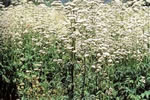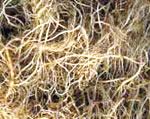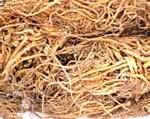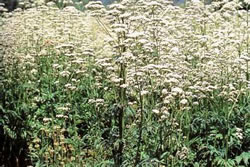Uses
The oil is used in the flavour and pharmaceutical industries, with limited quantities used in the fragrance industry. Valerian extracts and the essential oil are used in flavouring components in most major food product groups including alcoholic and nonalcoholic beverages, meat and meat products, frozen dairy desserts, sweets and baked goods. Store in closed containers protected from light, air, and moisture. Although the essential oil is relatively stable, it can evaporate with excessive exposure to air. The essential oil can degrade quickly in powdered material. In powdered root, the essential oil content can decrease by 50% within 6 months. Valepotriates are sensitive to humidity, temperatures above 40°C, and acid mediums (pH < 3) and are generally not detected in commercial products after 60 days.

Planting
When sown in Spring and growing in favourable conditions, Valerian plants grow large enough for harvesting in the following autumn. Sowing should be undertaken into fine, firm, weed-free land, which is rolled after sowing. Plant 3kg of seeds per ha using a mechanical planter. Valerian seed should be sown close to the surface to aid germination. The seed takes 2-3 weeks to germinate. Once the plant starts growing it requires little management. Valerian requires fertile soil, the following need to be applied:
- 100-150 kg/ha of nitrogen, in split applications during the growing season
- 100kg/ha of phosphorus and 200kg/ha of potassium fertiliser during soil preparation
- A fertiliser containing NPKS in a ratio of 15:10:10:8 applied at 500 kg/ha
These will provide adequate initial nutrition tied to a follow-up dressing of nitrogen.

Growing
Valerian can be easily propagated, grown and harvested. It is not particular about soil type, and will grow in many climates hot or cold, wet or dry - providing that it gets sufficient water and nitrogen. Valerian thrives best in rich, heavy loams with adequate moisture but with free drainage. For ease of post harvest root washing, a relatively loose soil with low clay content is ideal. In the absence of irrigation, soil will also need to have good water-holding capacity. Cutting off the flowering tops before the plant has set seed causes the rhizome to develop more fully. Good weed control is essential to achieve acceptable yields of valerian.

Drying
For maximum preservation of the essential oils, valerian should be dried at 40°C with a flow rate of 0.05 kg/sec/m2. Alternatively, drying at room temperature (20°C) for approximately 10 days, shade drying at approximately 45 °C, low temperature vacuum-drying, and freeze-drying are also appropriate drying techniques. When dried at 50 °C as compared with drying at 20 °C, there is a 50% decrease in essential oil content. Properly dried valerian will produce valerianic aroma over time.
Extraction
The essential oil is located in the hypodermis of the rhizome in large thin-walled cells. Because of this, care must be taken not to damage these cells during handling. Excess washing of the roots can result in a significant reduction of extractive matter. The sensitivity of volatile oils to heat, it is necessary to minimise the amount of time generated in the grinding or powdering process by doing small lots at a time, with frequent interruptions in run times, or by utilizing a cryogenic grinder. Valerian oil is obtained from the steam distillation of the dried, ground roots and yield is reported to be between 0.4 and 0.7%.

 Proud to be
Proud to be